

Ultrasound-Guided Microthrombectomy: An Effective Symptomatic Treatment For Uncomplicated Superficial Venous Thrombophlebitis Agnieszka Witkowska MD 1 , DaeHee Kim MD 1,2 , Ali Ardestani MD MSC 1 , Christopher Bolus MD 1 , Shams Iqbal MD 1 , Christopher Molgaard MD 1 , Heideh Ahari MD 1 , Sebastian Flacke MD PHD 1 , Brian Davison MD 1,3 1- Department of Radiology, Lahey Hospital and Medical Center, Burlington, MA, USA 2- Memorial Sloan Kettering Cancer Center, New York, NY, USA 3- The Vanishing Vein, Framingham, MA, USA
Disclosures • Authors have no conflict of interest in relation to this presentation.
Background • Superficial thrombophlebitis is an inflammation of a vein due to blood clot in a vein located just below the skin's surface. • The incidence is unclear; thought to be higher than that of deep vein thrombosis, which is estimated at one per 1000. 1 • Standard treatment includes: • Heat • Elevation • NSAIDs • Compression stockings • Often improves on its own, but can be very painful and prolonged.
Background Microthrombectomy: • Classically used to prevent post-sclerotherapy skin hyperpigmentation. • Anecdotally utilized for symptomatic relief from venous wall distention by the clot.
Objective • To assess the efficacy of this minimally invasive technique in patients with uncomplicated focal superficial venous thrombosis (SVT).
Methods: Procedure Longitudinal ultrasound Under the real-time image demonstrates sonographic guidance, a 21 non-compressible, gauge needle is advanced thrombosed, dilated into the center of the superficial saphenous thrombosed superficial tributary vein. vein.
Methods: Procedure Typical appearance is The content is aspirated usually dark deoxygenated into a syringe. blood/currant jelly consistency fluid. After the initial aspiration additional material can often be expelled through the puncture site.
Methods: Procedure The area of treatment is Post-drainage transverse indicated by the finger. ultrasound image demonstrates the collapsed vein.
Methods: Study Population 98 patients with focal leg pain and fullness + documented venous insufficiency by Doppler ultrasound at an outpatient vein clinic 48 patients w/o prior SVT or vein treatment • 50 patients w/ recent sclerotherapy (45) or EVLT (5) • Mean age 48 (age range 31-78) • 65% female / 35% male • Included Excluded 33 patients 65 patients with alternative diagnosis SVT (+)
Methods: Study Population 33 patients SVT (+) 12 (36%) 21 (64%) Thrombosed varicosity Focal SVT (<3cm) within tributaries after prior vein treatment w/o prior vein treatment 7 (58%) 3 (25%) 2 (17%) SVT extending into GSV Isolated segmental Multifocal SVT within (> 10cm away from the saphenous tributary SVT tributaries saphenofemoral junction)
Results 33 patients SVT (+) Excluded 1 32 Treated with systemic Treated with LMWH due to progressive ultrasound-guided extension of SVT needle microthrombectomy 12 (38%) No recurrent symptoms 1 (3%) Assessment No relief of 17 (53%) 31 (97%) of pain using symptoms 5–grade pain Mild residual symptoms Immediate scale on post- procedure pain relief appointment. 3 (9%) Recurrent symptoms
Summary • Significant portion (33.7%) of the patients with focal leg pain had SVT within varicosity or posttreatment veins. • No intra- or post-procedural complications observed. • Very high immediate treatment response rate was observed (96.9%). • 38 % without recurrent symptoms. • 62% with mild residual or recurrent symptoms; however, given low risk, it can be repeated in those patients.
Conclusion Percutaneous needle microthrombectomy is an effective symptomatic treatment in uncomplicated SVT, which can be performed and repeated in an outpatient setting without significant risk.
References • 1. Nagarsheth, K. H., & Rosh, A. J. (2017, August 17). Superficial Thrombophlebitis (V. L. Lopez, Ed.). Retrieved September 10, 2017, from http://emedicine.medscape.com/article/463256- overview?src=refgatesrc1&pl=1 • 2. Zelikovski, A. Haddad, M., Sahar, G. and Reiss, R. (1986). The role of ambulatory surgery of thrombosed varicose veins. Phlebology, I, 135- 137 • 3. Hobbs, J.T. (1977) Superficial thrombophlebitis. In The Treatment of Venous Disorders (ed. J.T. Hobbs), MTP, Lancaster, pp. 414-427
Thank you Questions?
Recommend
More recommend